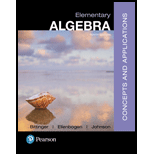
Concept explainers
To calculate: The number of each type of coins if a collection of nickels and quarters is worth
Answer to Problem 1RVS
Solution:
The number of nickels are 27 and the number of quarters are 32 and the correct option is
Explanation of Solution
Given Information:
The provided options are,
And,
Formula used:
According to the elimination method, a set of equations is simplified by using the addition principle.
(1) The coefficient of one variable, of one equation, is converted to the opposite sign of the coefficient of the other equation.
(2) The equations are added and one variable is removed from the set of equations.
(3) The value of the variable is used to find the value of the other variable.
(4) Check by substituting the values of the variables in the equations.
According to the distributive property, for numbers a, b and c,
Calculation:
Consider the number of nickels to be x and the number of quarters to be y.
The value of a nickel is
Multiply both sides by
There are 59 coins in total, so,
Hence, the correct option is J.
Multiply the equation (2) by
The coefficients of the variable x are same and of opposite signs, thus, apply the elimination method by adding (1) and (3),
Divide both sides by 4,
Substitute 32 for y in (2),
Subtract 32 from both sides,
Thus, there are 32 quarters are 27 nickels. Check by substituting 27 for x and 32 for y in the equations (1) and (2).
For equation (1),
This is true. Now, for equation (2),
This is true.
Hence, there are 32 quarters are 27 nickels and correct option is J.
Want to see more full solutions like this?
Chapter 8 Solutions
Elementary Algebra: Concepts and Applications (10th Edition)
- In simplest way, For each quadratic relation, find the zeros and the maximum or minimum. a) y = x 2 + 16 x + 39 b) y = 5 x2 - 50 x - 120arrow_forwardIn simplest terms and step by step Write each quadratic relation in standard form, then fi nd the zeros. y = - 4( x + 6)2 + 36arrow_forwardIn simplest terms and step by step For each quadratic relation, find the zeros and the maximum or minimum. 1) y = - 2 x2 - 28 x + 64 2) y = 6 x2 + 36 x - 42arrow_forward
- Write each relation in standard form a)y = 5(x + 10)2 + 7 b)y = 9(x - 8)2 - 4arrow_forwardIn simplest form and step by step Write the quadratic relation in standard form, then fi nd the zeros. y = 3(x - 1)2 - 147arrow_forwardStep by step instructions The path of a soccer ball can be modelled by the relation h = - 0.1 d 2 + 0.5 d + 0.6, where h is the ball’s height and d is the horizontal distance from the kicker. a) Find the zeros of the relation.arrow_forward
 Algebra: Structure And Method, Book 1AlgebraISBN:9780395977224Author:Richard G. Brown, Mary P. Dolciani, Robert H. Sorgenfrey, William L. ColePublisher:McDougal Littell
Algebra: Structure And Method, Book 1AlgebraISBN:9780395977224Author:Richard G. Brown, Mary P. Dolciani, Robert H. Sorgenfrey, William L. ColePublisher:McDougal Littell
 Elementary AlgebraAlgebraISBN:9780998625713Author:Lynn Marecek, MaryAnne Anthony-SmithPublisher:OpenStax - Rice University
Elementary AlgebraAlgebraISBN:9780998625713Author:Lynn Marecek, MaryAnne Anthony-SmithPublisher:OpenStax - Rice University- Algebra & Trigonometry with Analytic GeometryAlgebraISBN:9781133382119Author:SwokowskiPublisher:Cengage
 Holt Mcdougal Larson Pre-algebra: Student Edition...AlgebraISBN:9780547587776Author:HOLT MCDOUGALPublisher:HOLT MCDOUGAL
Holt Mcdougal Larson Pre-algebra: Student Edition...AlgebraISBN:9780547587776Author:HOLT MCDOUGALPublisher:HOLT MCDOUGAL College Algebra (MindTap Course List)AlgebraISBN:9781305652231Author:R. David Gustafson, Jeff HughesPublisher:Cengage Learning
College Algebra (MindTap Course List)AlgebraISBN:9781305652231Author:R. David Gustafson, Jeff HughesPublisher:Cengage Learning





